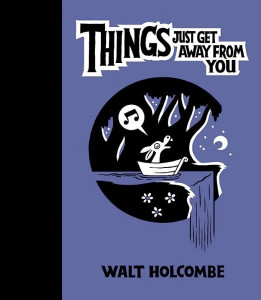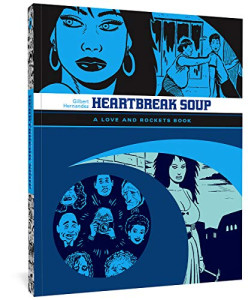 The graphic novel has come a long way since it was created as ten or so monthly issues of a comic book, compiled between one cover, maybe with a few extra sketches, and a new cover painting for added interest. Truth be told the two Hernandez collections under consideration here began life in just that way. And the Holcombe book is more of a “greatest hits” collection than a novel. But the Modan book is one long sustained story. The Los Bros’ stories are long sustained pieces too, albeit more like a movie serial from the ’40s. What links these four volumes, though, is the way they tell stories, with words and pictures. They do so in a variety of styles. The language they use (the words) is individual, specific to the artist/writer, and completely unique. No one book is quite like the other, no one artist is like another except that each one is a master of the form. Black & white and in colour — the comic book (for there is no better word to describe these books) is here to stay.
The graphic novel has come a long way since it was created as ten or so monthly issues of a comic book, compiled between one cover, maybe with a few extra sketches, and a new cover painting for added interest. Truth be told the two Hernandez collections under consideration here began life in just that way. And the Holcombe book is more of a “greatest hits” collection than a novel. But the Modan book is one long sustained story. The Los Bros’ stories are long sustained pieces too, albeit more like a movie serial from the ’40s. What links these four volumes, though, is the way they tell stories, with words and pictures. They do so in a variety of styles. The language they use (the words) is individual, specific to the artist/writer, and completely unique. No one book is quite like the other, no one artist is like another except that each one is a master of the form. Black & white and in colour — the comic book (for there is no better word to describe these books) is here to stay.
Sure, some would prefer to tag these as “sequential art” or some such high falutin’ term in an attempt to lift them from the superhero or funny animals world from which they grew. But really, the goals of Holcombe, Hernandez (x2) and Modan are not that far removed from Donald Duck as one might pretend. Look at Things Just Get Away From You. Walt Holcombe writes from his “cottage in the Vallee-Loire” in the preface, listing some of his influences. He chooses “Spike Jones over Iron Maiden, Wee Willie Winkie over football. . .” he dreams, and awakes to find “empty bottles of anise (a liqueur I detest), the remains of a whole fried chicken and a grubby issue of Little Lulu.” And he wonders, “was it just a dream?”
His stories are bizarre fables rendered in crisp B&W in a jazzy style that harkens back to the past. Back to the time of Spike Jones perhaps. Written in a language that is awkward and yet poetic, Holcombe tells his fables with humour and pathos. The basis for “The King of Persia” (an Eisner Award winner in 1997) is stated in one brief line: “the king of Persia was lonely!” He falls for a “comely young peasant  woman” who has lost in love and doesn’t trust him. What will he do? He asks his faithful camel. Sure, the animals talk, but not everyone can understand them. Good things happen, then bad things, then hopeful things, and I just can’t tell you how it all ends up. You simply must read these tales for yourself to appreciate the rhythmic pacing, the flow of his line, the balance of blacks and whites. Aubrey Beardsley theorized that the perfect drawing would have black and white in equal amounts on the page. And it’s not a bad practice, one which Holcombe seems to adhere to.
woman” who has lost in love and doesn’t trust him. What will he do? He asks his faithful camel. Sure, the animals talk, but not everyone can understand them. Good things happen, then bad things, then hopeful things, and I just can’t tell you how it all ends up. You simply must read these tales for yourself to appreciate the rhythmic pacing, the flow of his line, the balance of blacks and whites. Aubrey Beardsley theorized that the perfect drawing would have black and white in equal amounts on the page. And it’s not a bad practice, one which Holcombe seems to adhere to.
Things Just Get Away From You also includes “Swollen Holler,” “Hails at Sea,” and more. A gorgeous, if quirky, collection.
Los Bros Hernandez have been publishing their joint venture Love and Rockets since the early ’80s. They took a break for a while, but are back to the drawing board with Love and Rockets Volume 2, a quarterly. The two volumes represented here are some of their earlier stories.
In the beginning L&R had stories by three Hernandez brothers, each with his own style of drawing and writing. Not sure what happened to older brother Mario, but Gilbert (Beto) and Jaime (Xaime) are still very active. They wear their influences proudly – Archie, Marvel superheros, and Dennis the Menace – but combine them with punk rock and a healthy dose of Mexican-American pride to come up with something that is totally their own. Totally individual too!
Beto invented a tiny Central American town called Palomar, and began to tell the stories of its inhabitants. Heartbreak Soup chronicles the first 20 stories of that ongoing series. The drawings are exquisite. Gilbert is a different kind of artist than  Jaime. You can see the fraternal connection but there’s more of the cartoonist (the Dennis the Menace influence) and more surrealism in Gilbert’s art than in his brother’s. His characters are strong and memorable. In fact both brothers favour powerful female leads. The iconic Luba is Beto’s major creation; Maggie and Hopey the main stars of Jaime’s work.
Jaime. You can see the fraternal connection but there’s more of the cartoonist (the Dennis the Menace influence) and more surrealism in Gilbert’s art than in his brother’s. His characters are strong and memorable. In fact both brothers favour powerful female leads. The iconic Luba is Beto’s major creation; Maggie and Hopey the main stars of Jaime’s work.
Jaime’s world is the barrio, populated with punk rockers and female wrestlers, but in these early stories he began with some fairly straight sci-fi. Maggie worked as a mechanic, fixing rockets in the dinosaur infested jungles. I loved these stories when I first read them. They are what drew me to L&R in the first place. As the stories and Jaime’s concerns moved along, and Maggie retired from the jungle, moved back to the barrio, took up with Hopey, gained a few pounds and began to have serious man/woman trouble, it required a leap of faith for me to journey on with her. But it was worth the trip. While both brothers have expanded their parameters, it’s been an adventure to keep up. These early stories, as I said, first caught my attention. I’ve read them in several different formats, and they are still well worth reading. Both of them draw women who look like real women, with flesh on their bones, possessing weight and presence.
They are masters of pen and ink. But their stories are fascinating as well. And without the tales, a graphic novel is nothing more than ink on paper. Check out both Heartbreak Soup and Maggie the Mechanic, and anything else these two produce!
Finally, for today, there’s an all colour graphic novel, published by the Canadian company Drawn + Quarterly. Beautifully bound in hardcover, with embossed lettering and exquisite colouring of stunning drawings by Tel-Aviv artist Rutu Modan, Exit Wounds is a modern classic. It tells the story of a young Israeli taxi-driver whose father left the family for another woman a few years back. The cabbie Koby Franco receives a message from a female soldier named Numi. She believes that Franco’s father (her lover) has been killed in a suicide bombing. Their investigation opens wounds of all sorts.
I could not stop reading this one. I started it, just planning to browse through one night at bedtime, I stayed up til the book was done. It is a moving, and sensitive piece. Literature with pictures. The images have the quality of Tintin about them, simple yet profound. The story echoes that profundity. While you don’t notice the lack of colour in the other three books, the addition of colour really helps tell this story. It is wonderfully handled, and presented.
(Fantagraphics Books, 2007)
(Fantagraphics Books, 2007)
(Fantagraphics Books, 2007)
(Drawn & Quarterly, 2007)
